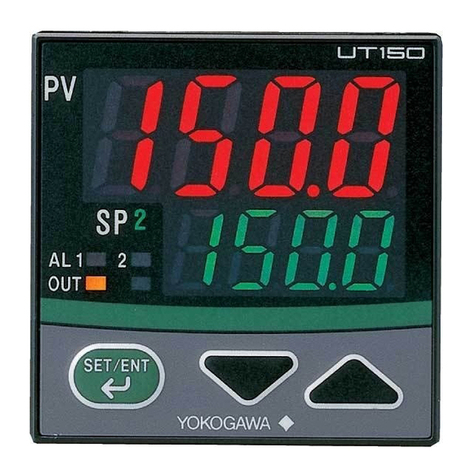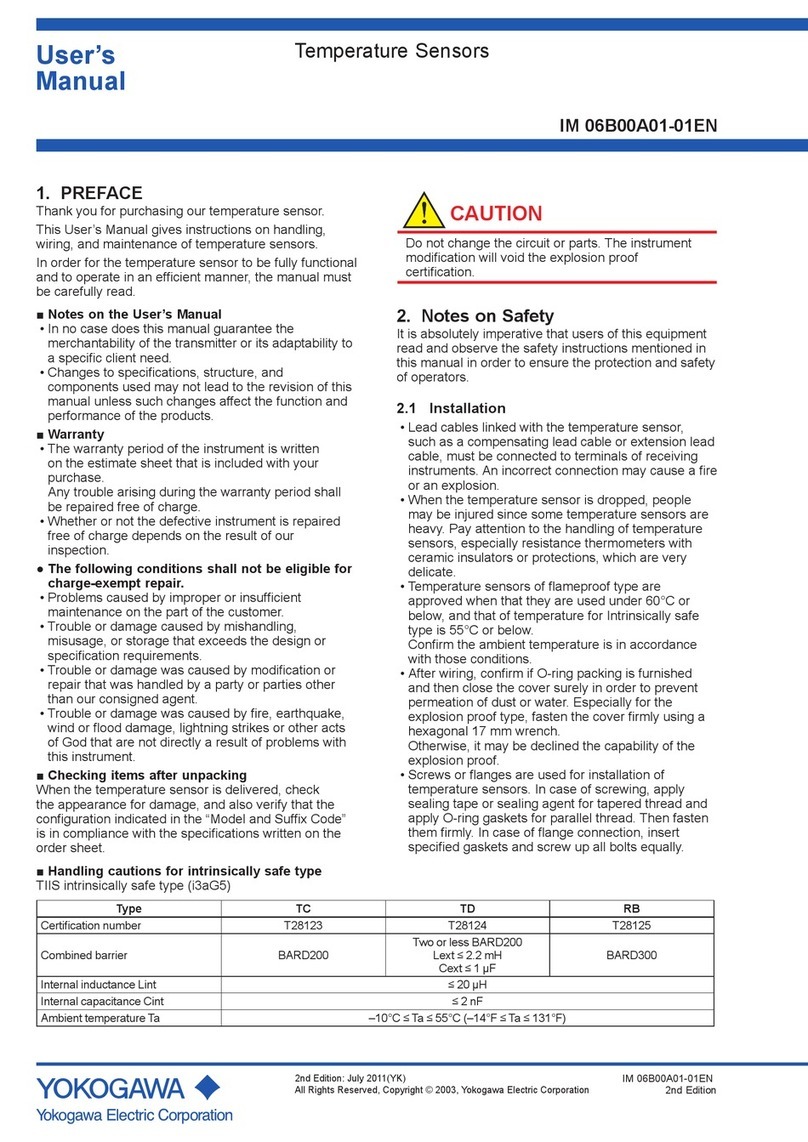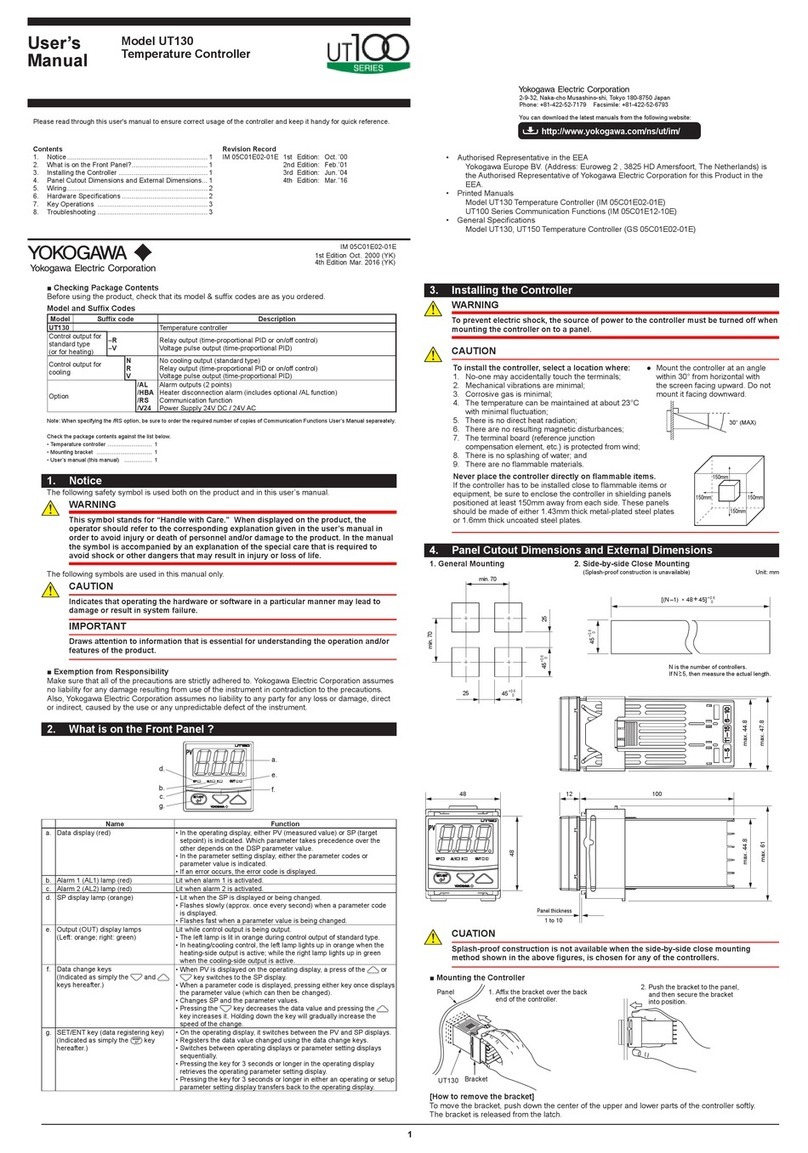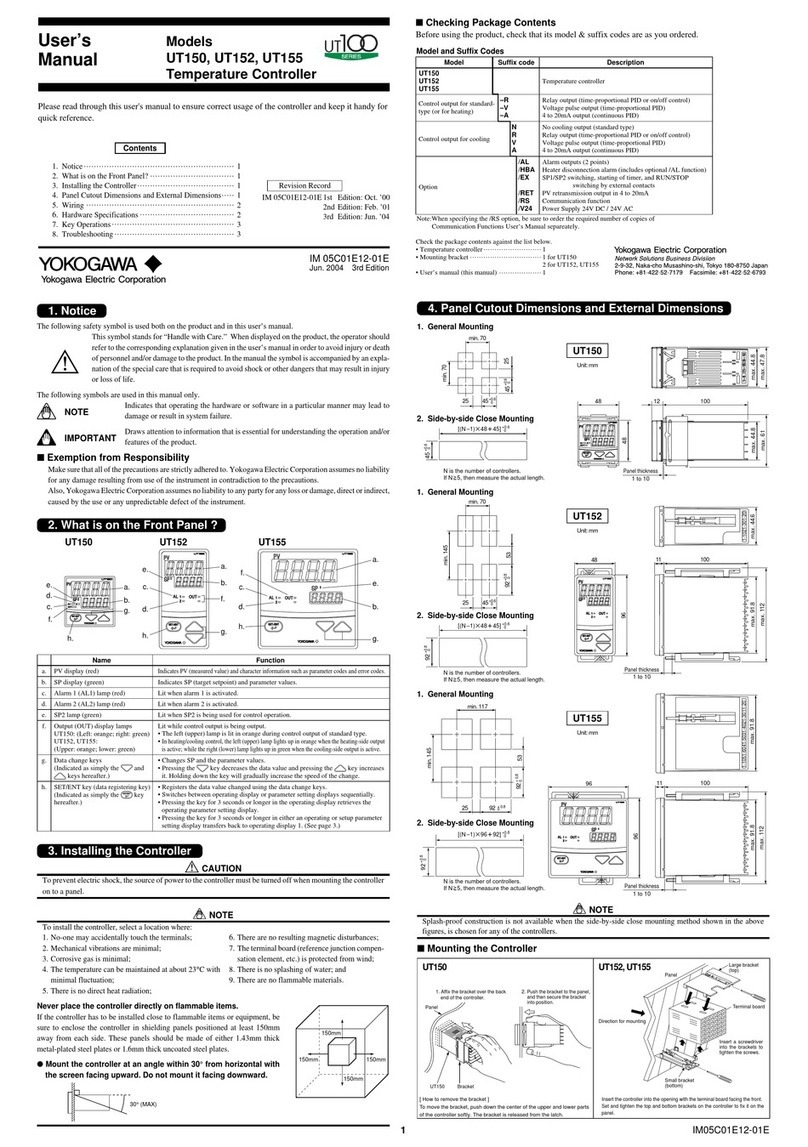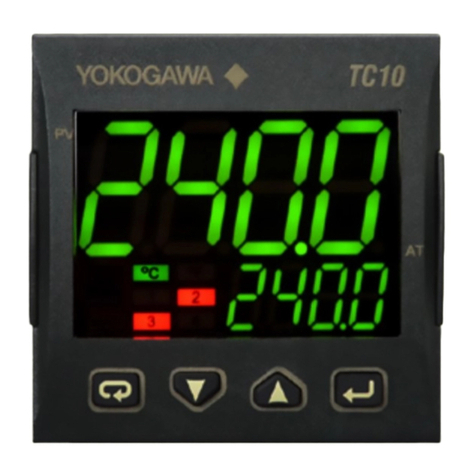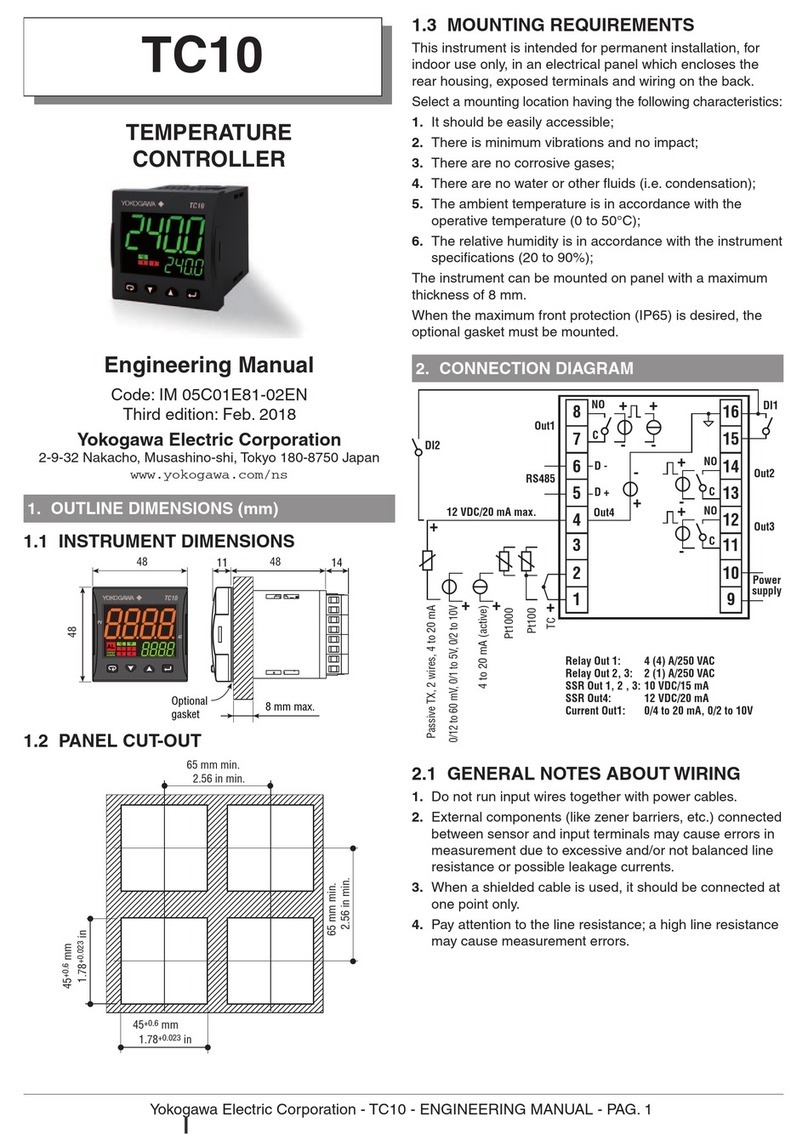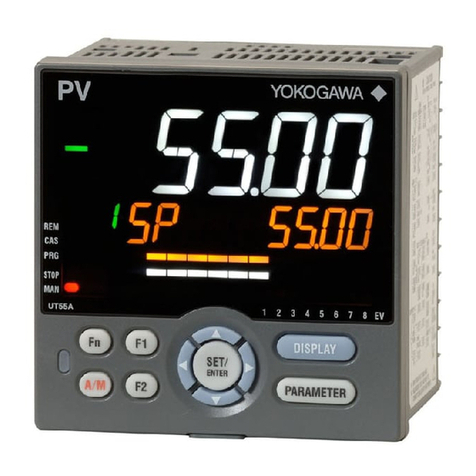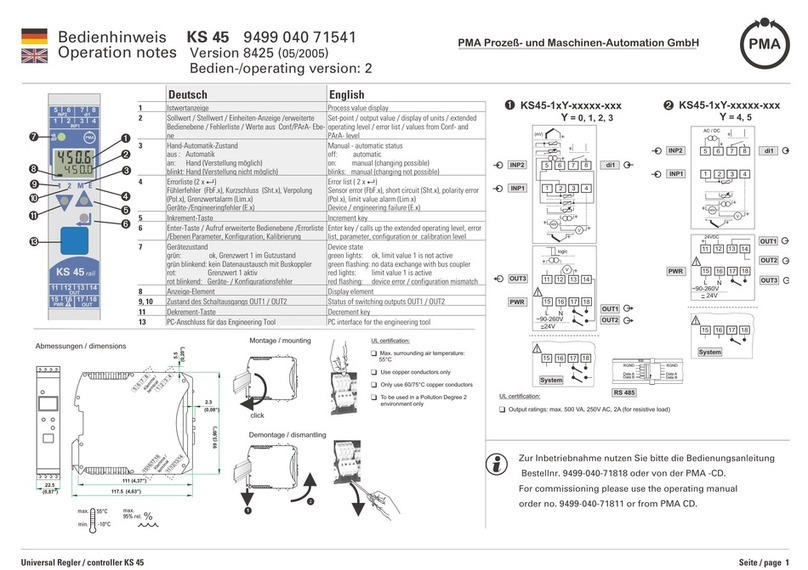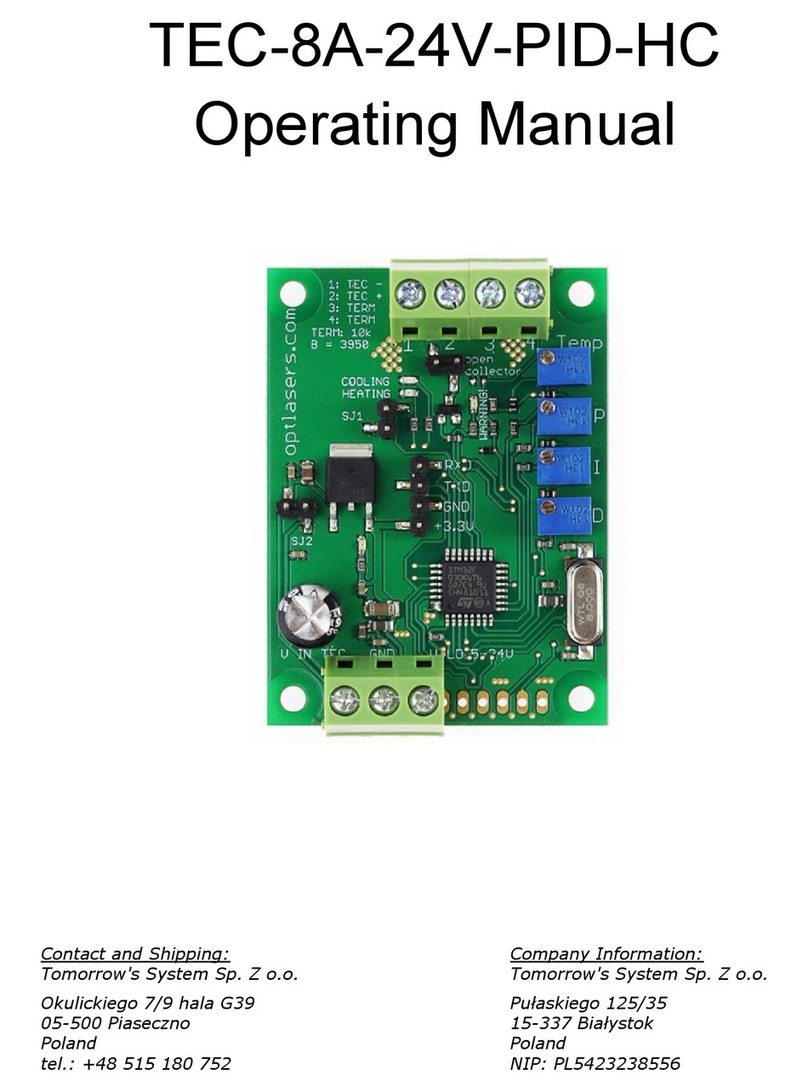4
IM05C01F12-01E
CTL Control mode ONF(0): On/off control
PID(1): PID control
OFF(0): Cancel Hold
ON(1): Hold
(Displayed when a program operation is started.)
PID(1)
AT Auto-tuning OFF(0): Stop auto-tuning
ON(1): Start auto-tuning
(Displayed when a program operation is started.) OFF(0)
P
Proportional
band 1°C/°F to the temperature that corresponds to 100% of the
measured input range (scale) span 5% of measured input
range (scale) span
IIntegral time 1 to 3600 seconds;
OFF(0): No integral action 240 seconds
D
Derivative
time
1 to 3600 seconds;
OFF(0): No derivative action 60 seconds
MR Manual reset
50.0%
–100 to 100%
HYS
Hysteresis for
on/off control 0°C/°F to the temperature that corresponds to 100% of the
measured input range (scale) span
0.5% of measured
input range (scale)
span
CT
Control output
cycle time 1 to 240 seconds 30 seconds
FL PV input filter OFF(0), 1 to 120 seconds OFF(0)
BS PV input bias –100 to 100% of measured input range (scale) span 0% of measured input
range (scale) span
LOC
Key lock 0
(1) Operating Parameters
HOLD
Program hold OFF(0)
OFF(0): Not execute advance
ON(1): Execute advance
(Displayed when a program operation is started.)
ADV
Segment
advance OFF(0)
Program
parameter
setting
0: Go to “CTL”setting display.
1: Enter the program parameter setting display
(Displayed when a program operation is stpped.) 0
PRG
0: No key lock (Note)
1: No key lock (Note)
2: Prevents all parameter changing operations
–1: Set ⬙-1⬙to enter the setup parameter setting display.
But if ⬙LOC=1 or 2⬙is already set, the parameter value can
not be changed by setting ⬙LOC=-1⬙only. To change the
parameter value, set ⬙LOC=0⬙at first (for disabling keylock),
then set ⬙LOC=-1⬙once again.
(Note) Both 0 and 1 are No key lock.
■Parameter Lists
Code Setting range and unit Default User settingName
Numbers in ( ) are the parmeter setpoints that apply when the
communication function is used. Ex. OFF(0), ON(1)
Parameters changed rather frequently during operation.
When creating a program, set the prameter PRG=1 to display the
program parameter setting display.
IN
Measured input
type
1 to 23, 31 to 48
(See measured input range code list.) (See page3)
OFF(0): No input
(If no measured input type is specified at the time of ordering,
you must set the measured input type.)
OFF(0) or
the input range code
specified with order
DIS DI-function
selection
OFF(0):Function of /EX does not work
ON(1):Terminals (3)-(5) Hold when DI=ON
Cancel hold when DI=OFF
Terminals (4)-(5) Start program operation when DI=ON
Stop program operation when DI=OFF
Note: When DIS=ON, the operation mode can not be changed by
key operation. However, only the RESET key is operable.
OFF(0)
SC SUPER
function ON(1): Uses the SUPER function
OFF(0): Does not use SUPER function OFF(0)
DR
Direct/reverse
action 0: Reverse action
1: Direct action 0
TMU Program time
unit
Sets the time unit of a program.
0: hour,minute
1: minute,second 0
RTH
RTL
RL
RL
DP
ADR Controller
address
1 to 99
However, the number of controllers that can be connected per
host device is 31 at the maximum. 1
BPS Baud rate
2.4(0): 2400 bps
4.8(1): 4800 bps
9.6(2): 9600 bps 9.6(2)
PRI Parity NON(0): Disabled
EVN(1); Even parity
ODD(2): Odd parity EVN(1)
STP Stop bit 1 or 2 bits 1 bit
DLN Data length 7 or 8 bits
•8 bits when ladder, MODBUS (RTU)
•7 bits when MODBUS (ASCII) 8 bits
PSL
Protocol
selection
0: PC-link communication
1: PC-link communication with sum check
2: Ladder communication
3: MODBUS in ASCII mode
4: MODBUS in RTU mode
0
(2) Setup Parameters
Code Name Setting range and unit Default User setting
Decimal point
position of
measured input
0: No decimal place (nnnn)
1: One decimal place (nnn.n)
2: Two decimal places (nn.nn)
3: Three decimal places (n.nnn)
1
Maximum value
of measured
input scale 100.0
Minimum value
of measured
input scale –1999 to (RH –1) 0.0
(Displayed at voltage input)
(RL + 1) to 9999
(Displayed at voltage input)
(Displayed at voltage input)
Maximum value
of retransmission
output
Minimum value
of retransmission
output
Temperature input : Within measured input range
Voltage input : (RTL+1digit) to max. value of measured input
scale (RH)
Min. value of measured input scale (RL) to (RTH-1digit)
However, RTL<RTH
Maximum value of
measured input range
(scale)
Minimum value of
measured input range
(scale)
SPH
SPL
Maximum value
of program
setting range
Minimum value
of program
setting range
(SPL+1digit) to max. value of measured input range (scale).
Min value of measured input range (scale) to (SPH-1digit)
Unit:°C/°F
Note that SPL<SPH
Place limits on the program setting range within the measured
input range (scale) to prevent a program setpoint from being
beyond the limits of setting range by mistake.
Maximum value of
measured input range
(scale)
Minimum value of
measured input range
(scale)
Numbers in ( ) are the parmeter setpoints that apply when the
communication function is used. Ex. OFF(0), ON(1)
Parameter rarely changed in normal use after once having been set.
Measured input range
PV retransmission range
(Factory-set default)
PV retransmission range
(after scaling)
RTL
RTL
Minimum value
of measured input
range (scale)
Maximum value
of measured input
range (scale)
RTH
4mA 20mA
RTH
PV retransmission output
(4 to 20mA)
……
……
……
……
……
*Note
STC Start code
0:
Program operation begins with the starting target setpoint.
1:Ramp-prioritized PV start
(program operation begins with the PV value by giving
priority to the ramp of segment 1)
2:Time-prioritized PV start
(program operation begins with the PV value by giving
priority to the time of segment 1)
0
SSP
Starting target
setpoint 0 to 100% of measured input range (scale) spanUnit:°C/°FMin. value of
measured input range
(scale)
SP1
Target setpoint 1
0 to 100% of measured input range (scale) spanUnit:°C/°FMin. value of
measured input range
(scale) Use the table blow
Use the table blow
Use the table blow
Use the table blow
TM1 Segment time 1 OFF(-1) or 0.00 to 99.59 (hour,min. or min,second)
Time unit is to be set in ”TMU”parameter. OFF(-1)
OFF(-1)
SP16
Target setpoint 16
0 to 100% of measured input range (scale) spanUnit:°C/°FMin. value of
measured input range
(scale)
TM16
Segment time 16
OFF(-1) or 0.00 to 99.59 (hour,min. or min,second)
Time unit is to be set in ”TMU”parameter.
JC Junction code 0: Reset
1: Hold
2: Repeat (repeat endlessly) 0
WTZ
*Note: •The setting range (scale) and unit of SPn (n=2 to 15) are same as those of SP1 (and SP16)
•The setting range (scale) and unit of TMn (n=2 to 15) are same as those of TM1 (and TM16)
■User Setting Table of Target SP and Segment time
SP n (n=1 to 16)
n=1 n=2 n=3 n=4 n=5 n=6 n=7 n=8 n=9 n=10 n=11 n=12 n=13 n=14 n=15 n=16
TM n (n=1 to 16)
Wait zone OFF(0) or 0 to 10% of measured input range (scale) span OFF(0)
A1 PV event 1
setpoint
•PV alarm: Min. value of measured input range (scale) to
Max. value of measued input range (scale)
•Deviation alarm:
–100 to 100% of measured input range (scale) span
Unit: °C/°F
0: PV event
1: Time event
Max. value of
measured input range
(scale) (PV alarm)
HY1 PV event 1
hysterisis 0 to 100% of measured input range (scale) spanUnit:°C/°F0.5% of measured
input range (scale)
span
EON1 Time event 1
on time OFF(-1) or 0.00 to 99.59 (hour,min. or min,second)
Time unit is the same as that of the program. OFF(-1)
EOF1 Time event 1
off time OFF(-1) (Note) or 0.00 to 99.59 (hour,min. or min,second)
Note: Time event 1 does not stop when “OFF”is set. OFF(-1)
EV2 Event 2 type 0: PV event
1: Time event 0
AL2 PV event 2 type OFF(0) or 1 to 10 (see the table of PV event function list
in User's Manual for Programming/Operation) 2
A2
PV event 2
setpoint
•PV alarm: Min. value of measured input range (scale) to
Max. value of measued input range (scale)
•Deviation alarm:
–100 to 100% of measured input range (scale) span
Unit: °C/°F
Max. value of
measured input range
(scale) (PV alarm)
HY2 PV event 2
hysterisis 0 to 100% of measured input range (scale) spanUnit:°C/°F0.5% of measured
input range (scale)
span
EON2
Time event 2
on time OFF(-1) or 0.00 to 99.59 (hour,min. or min,second)
Time unit is the same as that of the program. OFF(-1)
EOF2 Time event 2
off time OFF(-1) (Note) or 0.00 to 99.59 (hour,min. or min,second)
Note: Time event 2 does not stop when “OFF”is set. OFF(-1)
EV1 Event 1 type 0
OFF(0) or 1 to 10 (see the table of PV event function list
in User's Manual for Programming/Operation)
AL1 PV event 1 type 1
Code Setting range and unit Default User settingName
(3) Program Parameters
Numbers in ( ) are the parmeter setpoints that apply when the
communication function is used. Ex. OFF(0), ON(1)
Parameters for creating a program.
Parameter Function Parameter Function
Control mode
CTL
UP150 has two control mode.
Select one from the following:
a. PID control (PID)
b. On/off control (ONF)
Manual reset
MR
You can set this parameter only for control
without an integral action (when registered as
CTL=PID and I=OFF). The controller outputs the
manual reset (MR) value when PV=SP. For
example, if you set MR=50%, the controller
outputs (OUT) 50% when PV=SP.
Hysteresis for
PV evnets 1 and 2
HY1,
HY2
The PV events are output as relay outputs. Since a
relay has a limited service life, excessive on/off
actions will shorten the life of a relay. To prevent
this, you can set a hysteresis band for both PV
evnets 1 and 2 to moderate excessive on/off
actions .
DI-function
selection
DIS
•When DIS=ON, Mode can be switched by only
external contact input signal.
•In order to switch the Mode by key operation,
OFF must be set at DIS.
Note: UP150 can be switched into “RESET”
mode by key operation even if DIS=ON.
SUPER
function
selection
SC
The SUPER function is effective in the following cases:
a. An overshoot must be suppressed.
b. The rise-up time needs to be shortened.
c. The load often varies.
Note 1: The SUPER function will not work when
on/off control is selected, or I or D
constants is set at OFF in PID control.
Note 2: For some types of systems, the SUPER
function may not be so useful. If this is
the case, turn off the function.
Time event n*
on time
n*=1 or 2
EON1
EON2
Time event n*
off time
n*=1 or 2
EOF1
EOF2
The time event feature begins countdown when a
program starts running, and after the elapse of a
preset time, output an on-time event signal
(contact output ON) or off-time event signal
(contact output OFF).
Hysteresis for
on/off control
HYS
For on/off control (CTL=ONF), you can set a
hysteresis around the on/off point (SP) to prevent
chattering.
On/off point (Program SP)
Hysteresis
ON
OFF
The cycle time is the period of on/off repetitions of
a relay or voltage pulse output in time proportional
PID control. The ratio of the ON time to the cycle
time is proportional to the control output value.
Cycle time
t ON
t OFF
Control output
cycle time
CT
PV input bias
BS
This function adds a bias value to the measured
input value, and the result is used for display and
control computation.
This function is useful for carrying out fine
adjustment when the PV value is within the
required accuracy but it differs from the value
obtained by other equipment.
PV value inside the controller
measured input value
PV input bias
+=
ON :HOLD, OFF: Cancel HOLD
COM
3
4
5
ON:RUN,OFF:RESET
SEG1 SEG2 SEG3
SEG4
SEG5
Time
Program
pattern
Time
event ON time OFF time
Time Event Diagram
2-seconds filterInput 10-seconds filter
PV input filter
FL
This function should be used when the PV display
value may fluctuate greatly, for example, when the
measured input signal contains noise. The filter is
of the first-order lag type, and FL sets the time
constant. If a larger time constant is set, the filter
can remove more noise.
Maximum/minimum
value of
measured
input scale
RH,
RL
Decimal point
of measured
input
DP
For DC voltage input, the input signal can be scaled for the
particular engineering unit. For example, if you set the input
type (IN) at range code 22, the initial range is 0.0 to 100.0.
a.
Using DP, set the decimal point position fit for the
engineering unit you want to use. (In the example below,
the 2 digits to the right of the decimal point)
b.
Next, register the scale values of the measured input scale using
RH and RL. (In the example below, RH=10.00 and RL=0.00)
Initial scale 100.0 (5V)0.0 (1V)
10.00 (RH)0.00 (RL)
Measured input scale
(after being scaled)
R
egister the decimal point position using DP.
■Description of Parameters
Step 2:
To enter the operating parameter
setting display, press the
key for at least 3 seconds.
•“PRG”parameter appears in
the PV display.
Step 3:
Press the key once to
display “CTL”parameter.
In this example, PID control mode
is selected.
Step 4:
When On/off control mode is
required, press the key to
change control mode to On/off.
■Changing Control Mode (CTL)
The period flashes.
Step 5:
Press the key once to
register the setting.
Control mode is now changed.
To return to the operating display
➀, press the key for at least
3 seconds.
The period goes out.
Step 1:
Press the key for at least 1
second to reset the program
operation, and confirm that the
UP150 shows the operating
display ➀, ➁or ➂.
Confirm that “RUN”
lamp is not lit.
